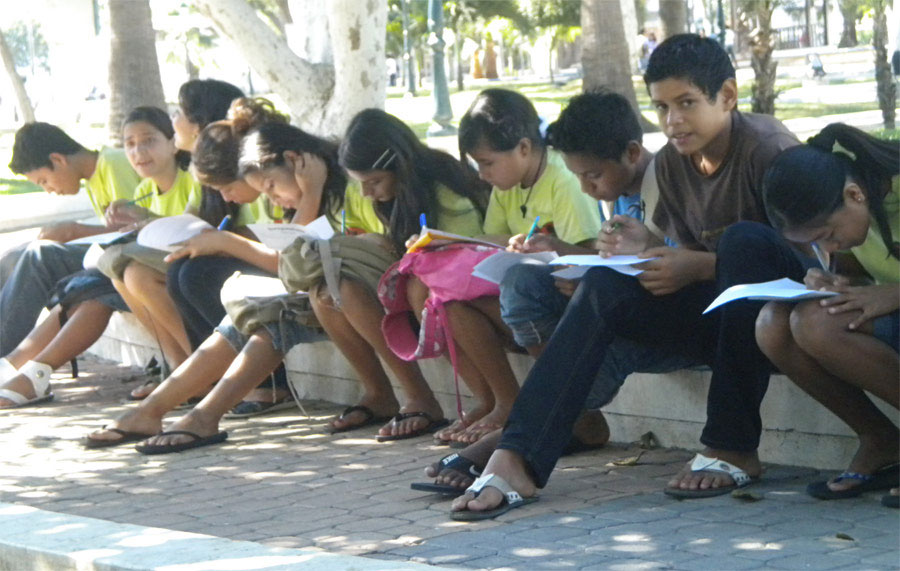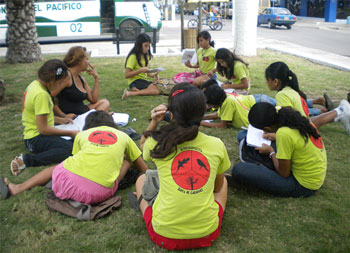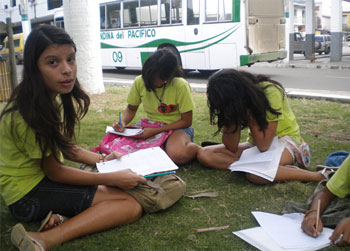Group C Professor: Margarita Avila [aka Plager-Unger]
Planet Drum Foundation
Bioregional Education Program
Final Reports 2010 – English
(Click here for Spanish/Español)
Photos below.
Report # 5
Topic: Land Ecosystems
Today I explained how animal and plant life develops and explained how humans are included in this cycle. It is the most practical way of learning more of about land ecosystems. We talked about the most important topics: habitat, forests, fauna and finca (farm), or human interaction with nature. We defined habitat as a place where species of animals and flora live. We discussed the diversity of the forest and the many species that inhabit this particular area.
Farms provided an example of the positive and negative impacts of human interaction with nature, including pollution, construction of roads and the various impacts of industry. The most important point of the exercise was to raise awareness among people of our region to encourage a change in thinking and create balance with the environment. Ramon told me that the kids were great and interacted a lot.
Fieldtrip: Cerro Seco
It was the second time that groups A, B, and C went together on a fieldtrip. Marcelo Luque worked with us and it really struck me how he and his assistants handled the three groups. They were our guides and they showed us, step by step, how to plant a tree, and the children participated in the activities.
The kids wanted to know if they could be volunteers. And they were charmed by the place. Luckily for Marcelo, a group of foreigners came to see the area and found the kids watering. They congratulated Marcelo Luque for educating the children about the environment so early on.
Report # 6
Flora Theme
The children took a test on everything they learned in the book; the best student in my group was Oscar Lucas. What an excellent child. We talked about how Ecuador is a diverse country because it contains the Sierra, the coast and lowlands, and the Oriente (jungle) and has a diverse range of flora with unique characteristics. We also discussed the importance of trees, characteristics, types of plants, and shrubs.
Our next subject was different ecological niches from humid zones to dry areas. We talked about the mangroves and their relationship with humans. To connect niches with their relation to humans we performed a special type of animated theater with the kids. I was ‘deforestation’ and I followed each of the children who represented different aspects of the environment. Afterwards each child had to give a positive message about their aspect.
Jefferson said: To be a part of the change, we need to pass on the information that we learned in this class to others so that we can have a better future.

Theme: Flora – Revegetation
Jorge Lomas
We walked to the revegetation site with a mother of the one of the families. Clay came with us as our guide. A mother of one of the girls in the class came along with the group. We began to carry the water needed for watering the trees. The mother participated with the group and helped us.
It was the afternoon of working together and the children asked Clay many questions, e.g., how many trees had to be watered and how long it takes the trees to grow. We shouldn’t forget about Carlitos, who is an excellent assistant and guide.
Report # 7
Topic: Soil
The topic today was the soil, which is a fundamental part of the biosphere. We talked about soil as an aspect of all life. The children learned about different soil types, and we discussed how to make compost.
The subject was extensive and interesting because many of the children did not know how little importance citizens give to our planet. They were interested in the class and commented on the negative and positive things that happen with soil and the low priority given to the problems that arise when citizens don’t protect the soil in their own neighborhood.

The Greenhouse
What an exciting day with lots of uproar and happiness on the bus. Arriving at the greenhouse, Orlando warmly welcomed us and we began explaining the subject matter of “how to transplant the seedlings” and all of the steps that go into the greenhouse from: how to prepare the compost, to how to nourish the earth, to how to plant a tree.
The task was fun because I taught them how to plant trees and in the end we planted 120 seedlings that day!
Report #8
Today in class I gave the children a different place to study: the beach of the bay. We began the class by cleaning the beach with the children but we couldn’t finish cleaning everything.
This gave the children an illustration of their own interactions with the environment and allowed us to take advantage of an opportunity to contribute to the area during our studies. We were actually having fun doing the task. Then we stopped to take a break in the dry sand to talk about the estuary and the importance of preserving it.
We talked about the water cycle, habitat, erosion, and sewage. During this discussion we took a moment to remember a little about what happens during the phenomenon of El Niño year. We distinguished between this natural event and humans’ interaction with nature, e.g. our contribution to soil erosion.
Field Trip
The group was so excited when I arrived. They were eagerly waiting for me because they knew we were going to go to go across the estuary. As we crossed in the barge, I began my explanation since we had a great view of the estuary from the barge. I talked to them about the mangroves and reminded them of the great variety of different species found in the mangroves and the importance of preserving this ecosystem. We walked to the bridge and the kids were surprised by the amount of debris and pollution that was there. This was a perfect example of things that humans should not do. We got back late but I took the trouble to call each parent to notify that all was well so the kids wouldn’t get in trouble.
Report #9
I was quite surprised this time, five children made landscapes out of recycled things. We talked a little about everything and we did a review of the most important points of the course. We worked with recycled bottle labels to prepare ourselves for our presentation.
Field Trip
Isla del Corazon
Click here to see photos of the trip to Isla Corazon.
This day everyone got together to go to Isla del Corazon. The people at Isla del Corazon welcomed the three groups of students, who were well organized. We boarded the boat and began to tell the children about the different types of mangroves still in existence. We taught them the important role that mangroves play in the ecosystem, as they give life to different species and provide oxygen for our environment. We saw different species such as tejeritos and frigates, and we talked about their gestation period. All the children were quite excited with the fieldtrip and with all of the new things they learned.
Report # 10
Today the kids took their final test. They were nervous but ready to fill out their questionnaires with everything they had learned. It took them a long time to answer the questions but we had time to finish a little more preparation work for the open house.

Field Trip
High tide had inconveniently come in at our scheduled time. We decided to take a walk to Punta Bellaca while looking at the landscape and going over the lessons we learned (throughout the course). We saw a mountain where you can see the types of soil, each of which provides a unique habitat for individual species. We spoke in particular about trees and saw the Guayacan that was beginning flower. Finishing the walk, the groups played games they knew and shared their topics and said they didn’t want bioregionalism to end!
Clausura (Closing Celebration) Class Report
Click here for pictures from the Closing Ceremony. It was a very packed but emotional day; we had to prepare the awards and dinner for 60 students. With the help of volunteers we prepared the salads and appetizers, chicken skewers and the fruit juice for the kids. Clay finished buying everything and brought the grill among other things to the beach.
Evening time came and all the students ate and played on the beach. Each child gave a presentation about what they learned, their experiences in the group and his or her new way of seeing the world.
Translated by Clay Plager-Unger
Profesor – Grupo C: Margarita Avila [alias Plager-Unger]
Fundacion Planet Drum
Programa de Educación Bioregional
Informes Finales 2010 – Spanish/Español
Informe #5
Tema: Ecosistema Terrestre
Se los explico ese día donde se desarrolla la vida animal vegetal, en la cual nosotros como seres humanos estemos incluidos. Es la manera más práctica de aprender más sobre nuestro Ecosistema Terrestre. Hablaron de lo sistemas más importantes:
Hábitat: lugar donde viven especies, vegetales y animales.
Bosques: Lugar muy diverso; un habitado por muchas especies.
Fauna: mamíferos, aves, reptiles
La importancia de la presencia de los seres humano.
Finca: los impactes negativos y positivos. Contaminación, carreteros, industrias.
De todos estos puntos mencionados lo más importante es concienciar a los habitantes de nuestra región para que haya un cambio de mentalidad y empiecen a vivir en equilibrio con el medio ambiente. Me comento Ramón que los chicos son pilas y que interactuaron mucho.
Tema Comunidad A Cerro Seco
Fue la segunda vez que los grupos A-B-C trabajaron juntos con nosotros y me llamo mucho la atención la forma en que Marcelo Luque y sus ayudantes manejaron los grupos. Ya que, fueron los guías y explicaron, paso a paso, su trabajo, como sembrar un árbol e incluso los chicos colaboraron con ellos.
Las preguntas de los chicos fueron si podían ser voluntarios. Y eran encantados por el lugar. Ese día para suerte de Marcelo, llegó un grupo de extranjeros a conocer el lugar encontrando a los chicos regando y lo felicitaron a Marcelo Luque por la obra que fomento a los niños desde temprana edad. Suerte por el la tarde. Terminó el día y jugábamos en la playa. Se paso increíble ese día.
Informe #6
Tema: Flora
Se tomó la prueba de todo lo aprendido en el libro. El mejor alumno de mi grupo fue Oscar Lucas Solía. Excelente el niño. Aprendimos como tratar la flora. Comentamos que Ecuador es un país diverso porque tiene costa, sierra, oriente y región insular y la diversa variedad de flora con sus característicos propios de cada una de los ya mencionados. Comente de la importancia de los árboles, y sus características.
Hablamos de los diferentes nichos ecológicos por ejemplo las regiones húmedas y secas. Después hablamos de las mangles y la relación que tienen con los seres humanos, deforestación, erosión, y reforestación entre otros. Fue muy animado, hicimos una especie de teatro con los chicos y cada uno representaba uno de los puntos mencionados y yo era la deforestación y los seguí para matar a la madre naturaleza y cada uno tenía que dar un mensaje de positivismo.
Jeferson dijo: Que teníamos que transmitir lo aprendido para hacer parte del cambio y tener una vida mejor al futuro.
Tema Flora: Sitio de Revegetación
Jorge Tomas
Caminando al sitio de revegetación una madre de la familia nos acompañó. Clay era nuestro guía. Junto con el grupo empezamos a cargar el agua necesaria para regar cada árbol sembrado y la mamá de la niña Pincay se envió al grupo y nos ayudó. Fue una tarde de integración y los chicos hicieron muchas preguntas a Clay. Referente a que cuantos árboles había que regar y que tiempo demoran los árboles en crecer. Solo me olvidé de Carlitos, el es un excelente asistente y guía a la vez.
Informe # 7
Tema: El Suelo
El tema de hoy día fue el suelo porque es la parte principal de la biosfera; la parte principal de la vida.
Discutimos como esta constituido y los diferentes tipos de suelo que hay. Hablamos del compost y como se contribuye al suelo. El tema fue extenso e interesante porque algunos niños no sabían las diferencias de desechos orgánicos e inorgánicos.
Se interesaran por la clase y comentaron las cosas negativas y positivas de la que pasa con el suelo y la poca importancia que los ciudadanos dan al no cuidarlo en su propio barrio.
El Vivero
Muy emocionante este día mucha alegría en el bus y cosas felices. Llegando al vivero nos dio la bienvenida Orlando, fue muy amable ya nos explicó parte por parte el tema que tratamos. Les explicó como se plantan las semillas y todas las etapas que pasan en el vivero desde como se prepara el compost para nutrir la tierra hasta como siembran un árbol.
La tarea fue divertida porque les enseñé como plantar árboles. Total en ese día sembramos 120 árboles con todos los chicos.
Informe # 8
Hoy la clase se los di en un lugar diferente: en el estuario de bahía, aprovechando nuestros alrededores. Limpiamos un poco la playa. Fue divertido. No terminaron la tarea. Nos sentamos en la arena. Les pregunté ¿Que es el estuario? ¿Cuál es la importancia de preservarlo? Hablamos sobre el ciclo de agua el hábitat, erosión, aguas servidas y recordamos un poco sobre lo que pasó en el recorrido, de esa manera, demostrando un poco de que manera tomamos que manejar el impacto de los seres humanos al medio ambiente.
Informe #9
Este día les tocó la prueba final. Los niños estaban nerviosos pero dispuestos a llenar el cuestionario de todo lo aprendido les tomó un largo tiempo contestar las preguntas, pero tuvimos tiempo para terminar un poco mas de los trabajos que presentaremos para la casa abierta.
Tuvimos un inconveniente con la naturaleza, el mar justo ese día estaba lleno a la hora fijada. De la misma manera los tres grupos íbamos juntos, tomamos la dirección de ayer. Una caminata a punta bellaca mirando el paisaje y recompilando lo aprendido pudimos ver una montaña la cual muestra los tipos de suelo el hábitat de otras especies hablamos de los árboles en especial vimos el Guayacán que ya empieza a florecer. Terminamos la caminata los grupos compartieron juegos se conocieron mas e intercambiaban temas y comentaban que no quería que se termine bioregionalismo.
Informe #10
Esta vez yo quedé sorprendida. Cinco chicos me llevaron paisajes hechos por ellos con recursos recicladas. Hablamos de todo un poco. Hablamos sobre los aves en el estuario hicimos un repaso de todo lo aprendido. Estamos recogiendo las etiquetas de botellas recicladas preparándonos para nuestra presentación.
En este día todos los grupos nos unimos para salir juntos para ir a Isla Corazón. Nos pusimos muy atentamente y en un filo ordenado subimos a la embarcación. Empezaron por enseñarnos los tipos de mangles. Nos enseñaron que los mangles hacen una función muy importante en el ecosistema, que dan vida a diferentes especies, que oxigenan nuestro medio ambiente, que hay diferentes formas en que hacen un grupos y que habían sembrado manglares. Vimos diferentes especias de aves. Todos fue bien explicando y los chicos hicieron muchas preguntas. Todos los chicos eran emocionados por el viaje y con todo lo nuevo que conocieron.

I don’t think the title of your article matches the content lol. Just kidding, mainly because I had some doubts after reading the article.
Your article helped me a lot, is there any more related content? Thanks!
Can you be more specific about the content of your article? After reading it, I still have some doubts. Hope you can help me.